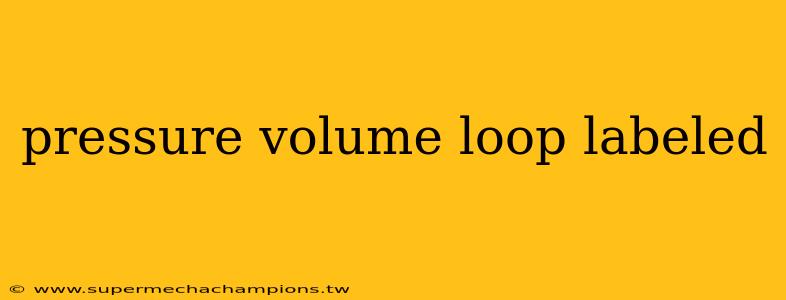Unveiling the Heart's Secrets: A Guide to Understanding the Pressure-Volume Loop
The heart, a tireless pump, works tirelessly to circulate blood throughout our bodies. Its efficiency and effectiveness can be visually represented through a powerful tool: the pressure-volume loop. This loop, a graphical representation of the left ventricle's performance during a single heartbeat, provides a comprehensive understanding of the heart's function in both health and disease.
What is a Pressure-Volume Loop?
The pressure-volume loop, also known as a PV loop, plots the pressure within the left ventricle against its volume during a single heartbeat. It captures the dynamics of ventricular filling, contraction, and ejection, revealing crucial information about the heart's ability to pump blood.
Let's break down the loop's components:
- Diastole (Filling Phase): This phase starts with the end-diastolic volume (EDV), the volume of blood in the ventricle before contraction. The ventricle relaxes, allowing blood to flow in from the atrium, represented by the filling segment of the loop.
- Systole (Contraction Phase): This phase begins with the isovolumetric contraction segment, where the ventricle contracts without changing volume, increasing pressure until it exceeds aortic pressure. This leads to the ejection segment where blood is pumped into the aorta, decreasing the ventricular volume.
- End-Systolic Volume (ESV): This represents the volume of blood remaining in the ventricle after ejection.
Why is the Pressure-Volume Loop Important?
The pressure-volume loop provides a wealth of information about the heart's performance. It allows clinicians to:
- Assess Ventricular Function: The shape and size of the loop can reveal whether the heart is pumping effectively.
- Identify Heart Disease: Changes in the loop, such as a smaller ejection fraction (the ratio of blood pumped out to the total blood volume), can indicate conditions like heart failure or aortic stenosis.
- Monitor Treatment Effectiveness: The pressure-volume loop helps evaluate the impact of medications or interventions on the heart's performance.
Deciphering the Loop: Key Metrics
Several key metrics derived from the pressure-volume loop provide further insight into the heart's function.
- Ejection Fraction (EF): As mentioned above, this is the percentage of blood pumped out of the ventricle with each beat. A normal EF is usually between 55% and 70%, indicating a healthy heart.
- Stroke Volume (SV): This is the amount of blood ejected with each heartbeat. A larger stroke volume indicates better cardiac performance.
- Preload: This refers to the stretch of the ventricle before contraction, indicated by the EDV. Higher preload usually leads to greater stroke volume.
- Afterload: This refers to the resistance the ventricle encounters during ejection, represented by the aortic pressure. Higher afterload can decrease stroke volume.
Applications of the Pressure-Volume Loop
The pressure-volume loop is a versatile tool used in:
- Cardiac Research: Researchers use PV loops to study the effects of various drugs and therapies on heart function.
- Clinical Settings: Cardiologists utilize PV loops to diagnose heart conditions, monitor treatment efficacy, and adjust medication dosages.
- Animal Studies: Researchers use PV loops in animal models to study the mechanisms of heart disease and test new treatments.
Understanding the Basics: An Analogy
Imagine a balloon being filled with water. The pressure within the balloon represents ventricular pressure, and the balloon's size represents ventricular volume. Filling the balloon (diastole) increases volume and pressure. Squeezing the balloon (systole) increases pressure while decreasing volume, representing the ejection of water (blood). The PV loop captures these dynamic changes throughout the "heartbeat cycle."
Conclusion
The pressure-volume loop is a powerful diagnostic tool that allows clinicians to understand the heart's performance in a visually intuitive way. By analyzing the loop's shape and key metrics, healthcare professionals can assess the heart's function, identify diseases, and monitor treatment effectiveness.
Remember, this information is intended for general knowledge and not a substitute for professional medical advice. If you have concerns about your heart health, please consult with a doctor.
References:
- "Pressure–volume loop: A comprehensive review": https://www.sciencedirect.com/science/article/pii/S0168827812004977 (S.E. Sundt, R.A. Nishimura, J.W. Miller, Journal of the American Society of Echocardiography, Volume 25, Issue 11, 2012, Pages 1182-1196, ISSN 0894-7317, https://doi.org/10.1016/j.echo.2012.08.009)
- "Pressure-volume loop analysis: A practical guide": https://www.sciencedirect.com/science/article/pii/S0168827815004963 (F.A. Pieske, M.A. Weber, Journal of the American Society of Echocardiography, Volume 28, Issue 9, 2015, Pages 952-964, ISSN 0894-7317, https://doi.org/10.1016/j.echo.2015.05.010)
Keywords: pressure-volume loop, PV loop, heart function, cardiac performance, left ventricle, diastole, systole, ejection fraction, stroke volume, preload, afterload, echocardiography, cardiac research, heart disease, treatment monitoring
